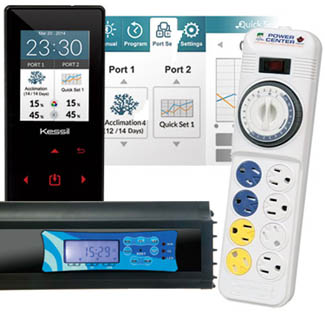|
How Long Should Aquarium Lights Be On?
|

|
We often get questions about the lighting schedules for aquarium lights. This primer gives advice on schedules. But before discussing schedules, we’ll go over why aquarium light is important.
1. You need light to see into your aquarium. While the organisms in your tank need light, aquariums lights are often turned on just for your viewing enjoyment.
2. Lighting gives your fish a source of Vitamin D, and they give your fish a natural daily rhythm. However, not much light is needed for fish to have adequate Vitamin D.
3. Lighting provides nutrition to your aquatic plants and corals. If you have plants or corals the amount of light and the lighting schedule is more critical than with a fish-only tank.
Here are our recommendations for fish-only, freshwater planted-tanks and reef tanks.
On/Off Lights, 6-8 Hour Lighting Schedule
For lights that simply turn on and off, you should leave your lights on for 6-8 hours a day. Even though the sun is up far longer than this, the sun does not shine at full strength all day. Leaving lights on for extended periods will lead to excessive algae growth. If your light does not have a
timer, then consider adding one to make sure that the lights are on for a consistent amount of time each day.
Our
T5/HO lights with just two bulbs and some of our less expensive
LED Fish-Only Aquarium Lights usually fit into this category.
Lights with Multiple Cords, Up to 12 Hour Lighting Schedule
(Peak Intensity 6 to 8 Hours)
For lights with multiple cords you can run your lights as long as 12 hours a day. Make sure that your lights are only at their peak intensity for no longer than 8 hours, as longer light periods can lead to algae. Most lights with multiple cords will have two or three cords for different color light bulbs. Most people will turn on the dimmer bulbs or blue bulbs for 1-2 hours and then turn on brighter bulbs for 6-8 hours followed by an additional period of just the dimmer or blue bulbs for another 1-2 hours (
with the dimmer or blue bulbs running the entire 8 to 12 hour period).
Light timers can help in creating this dawn/dusk effect.
These days most of the lights with multiple cords are the
T5/HO lights with four or six bulbs. When using combinations of lights, such as with the
AquaticLife Black T5/LED Hybrid Reef Lights or multiple of LED strips, you will have multiple cords and lights that can be controlled independently.
Lights with Dimming, Up to 12 Hour Lighting Schedule
(Peak Intensity 6 to 8 Hours)
In recent years more and more lights—especially LED lights—have built in dimmers. Dimmers are great for viewing your aquarium. The slow ramping-up and ramping-down of lights greatly adds to the look of an aquarium.
For lights with dimming you can run your lights as long as 12 hours a day. Make sure to only run your lights at their peak intensity for only 6 to 8 hours a day. Running your lights at high intensities for long periods can lead to excessive algae.
With dimmable LED lights we recommend you run just the dim/blue colored setting for 3 hours and then add the bright white lights for 6 hours and then transition back down to running only the dim/blue colored setting for another 3 hours before turning off all the lights (
with the dimmer or blue bulbs running the entire 12 hour period). You may have some very dim moonlights running for the other 12 hours.
There are several LED lights on the market with dimmers that are either built into the light or controllers that you connect the light to that dim the light. The
Kessil LED Lights, and
Fluval Sea Marine & Reef 3.0 LED Lights and most other high-end aquarium lights fall into this category.
Please note that there are some cheaper LED lights that have a sunrise/sunset period that typically lasts for half an hour, but do not have independent control over two or more light channels. In these cases you would not want to run the light more than eight hours a day because after a short ramp up period the light will be at full intensity.
There are also some LED lights that do not ramp-up and ramp-down (
get gradually brighter and dimmer). But they have two or more LED channels. In these cases you would treat each channel light like a separate power cord. Turn on the dimmer or blue LED channel for 1-2 hours, and then turn on brighter LED channel for 6-8 hours followed by an additional period of just the dimmer or blue LED channel for another 1-2 hours (
with the dimmer or blue LEDs running the entire 8 to 12 hour period).
Moon Lights
If you would like a moon light (
night light) make sure that you have a light that is specifically designed for this purpose. Many aquarists purchase regular lights that are too bright for night lights, resulting in excessive algae. True moon lights can stay on 24 hours a day. Many LED lights these days have moon light functions built in.




























